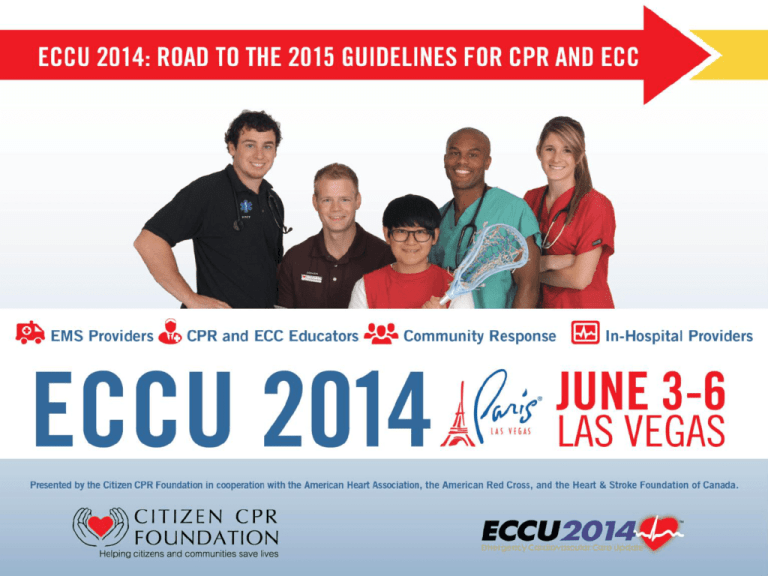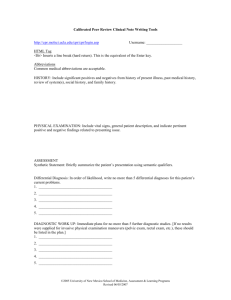
Presenter Disclosure Information
•
•
•
•
Colby Rowe
FINANCIAL DISCLOSURE:
No relevant financial relationship exists
No Unlabeled/Unapproved Uses in
Presentation
Two Inch
Compression
with Complete
Release
“Hard and
Fast”
At least 100
compressions per
minute
Good Release =
Good Venous Return to the Heart
Optimal Blood flow During CPR
100%
75%
Normal Blood Flow
50%
25%
Blood Flow During CPR
0%
Blood flow During CPR
with Under-compression
100%
75%
Normal Blood Flow
50%
25%
Blood Flow During CPR
0%
0
Blood flow During CPR with
Under-compression and Hyperventilation
100%
75%
Normal Blood Flow
50%
25%
0%
0
Blood Flow During CPR
Blood flow During CPR with Under-compression,
Hyperventilation and Long Pre-shock Pauses.
100
100%
75
75%
Normal Blood Flow
50
50%
Ventilation, defibrillation,
intubation, IV, drugs, etc.
25
25%
0%
0
Blood Flow During CPR
Chest Compressions and CPP
Coronary Perfusion pressure (Ao diastolic - RA diastolic)
Berg, Circ 2001
Shock Success by Compression Depth
Shock Success, Percent
P=0.008
n=10
n=15
n=17
n=5
Compression Depth, Inches
Dana P. Edelson , et al. Effects of compression depth and pre-shock pauses predict defibrillation failure during
cardiac arrest. Resuscitation, Volume 71, Issue 2, 2006, 137 - 145
Effect of Compression Depth on Survival
Sister Out-of Hospital data n= 284
35
% Admitted Alive
30
25
20
15
10
5
0
<1.2 inch
1
1.2 to 21.3 inch
1.3 to
3 1.6inch
Compression depth quartile
>1.64inch
Diagram of preshock, postshock, and perishock pause.
Cheskes S et al. Circulation. 2011;124:58-66
Copyright © American Heart Association, Inc. All rights reserved.
15
Pre-Shock Pause Duration and
Defibrillation Success
Association between preshock pause and shock
success.
Cases are grouped by preshock pause in 10 s
intervals. Note that longer
pre-shock pauses are
significantly associated
with a smaller probability of
shock success.
The quality of CPR prior to
defibrillation directly
affects clinical outcomes.
Specifically, longer preshock pauses and shallow
chest compressions are
associated with
defibrillation failure.
Dana P. Edelson , et al. Effects of compression depth and pre-shock pauses predict defibrillation failure during
cardiac arrest. Resuscitation, Volume 71, Issue 2, 2006, 137 - 145
Peri-Shock Pause and Survival
Pre-shock
pause, secs.
<10 secs.
10–19 secs.
≥20 secs.
Survival, %
35.1
35.5
25.1
Post-shock
pause, secs.
<10 secs.
10–19 secs.
≥20 secs.
Survival, %
31.8
30.8
22.7
Peri-shock
pause, secs.
<20 secs.
20–39 secs.
≥40 secs.
Survival, %
32.6
31.9
20.3
P=0.02
P=0.06
P=0.01
Cheskes S, et al; Resuscitation Outcomes Consortium (ROC) Investigators. Perishock pause: an independent
predictor of survival from out-of-hospital shockable cardiac arrest. Circulation. 2011 Jul 5;124(1):58-66.
Consecutive Case
Ventilation Rate
(breaths/min)
Ventilation
Duration
(secs./breath)
% Positive
Pressure
37 ± 4*
0.85 ± .07*
50 ± 4%
22 ± 3*
1.18 ± .06*
44. 8.2%5
±
Group 1
Mean ± SEM
Group 2
Mean ± SEM
*
p < 0.05
Aufderheide T, et al. Hyperventilation-Induced Hypotension During Cardiopulmonary
Resuscitation. Circulation. 2004; 109: 1960-1965.
Porcine Survival Study
Breaths/Minute
O2/CO2
Survival Rate
7 Pigs =12 BPM
100% O2
6/7 (86%)
7 Pigs = 30 BPM
100% O2
1/7 (14%)*
7 Pigs = 30 BPM 95% O2/5% CO2
1/7 (14%)*
*P < 0.05
Aufderheide T, et al. Hyperventilation-Induced Hypotension During Cardiopulmonary
Resuscitation. Circulation. 2004; 109: 1960-1965
Illustration of the Impact of Manual &
Automated Chest Compression on
Cerebral Perfusion in Two Patients
80
70
60
% rSO2
50
40
Start Automated CPR
30
20
10
Manual
CPR
Manual CPR
0
Automated CPR (patient 1)
Manual CPR (patient 2)
Time (mins)
Impact of automated CPR
on rSO2
80
*
rSO2%
60
40
20
0
Manual CPR
Automated CPR
* p= <0.0001 Mann-Whitney Test, (Manual CPR n=22, Automated CPR n=12)
Quality of Compressions
AHA Standards
Stapleton E. Quality of CPR During Transport. JEMS 1991Sep;16(9):63-4, 66, 68
Automatic CPR leads to higher Return
Spontaneous Circulation Following Cardiac Arrest
80
*
70
60
% ROSC
50
40
30
20
10
0
Manual CPR
Automated CPR
ROSC = Return of Spontaneous Circulation lasting > 20 mins.
*p < 0.05 using Fischer's Exact test. (Manual CPR n=44, Automated CPR n=20)
Saving the PEA’s and Asystole Patients!
by Fine Tuning Appreciation of H’s and T’s
H's
T's
Hypoxia
Toxins
Hypovolemia
Tamponade (cardiac)
Hydrogen ion (acidosis)
Tension pneumothorax
Hypo-/hyperkalemia
Thrombosis, pulmonary
Hypothermia
Thrombosis, coronary
What can Prehospital Providers
do for H’s and T’s anyway?
•
•
•
•
•
Decompress Tension Pneumothorax
Pericardiocentesis
Volume
Toxicology Antidotes
Treatment of Hyper/Hypokalemia
• Early notification
• “Trauma system strategy”
• “12 Lead ECG strategy”
H’s and T’s Process
1. Systematically consider - based
on the presenting problem
– Trauma = hypovolemia, tension
pneumothorax, tamponade
– History is a good first step!
2. How to recognize?
– Tamponade = Ultrasound
identification
3. How to treat?
– Tamponade = Pericardiocentesis
Potential
Usefulness of Ultrasound
•
•
•
•
•
•
•
Pneumothorax,
Tension Pneumothorax
Pericardial Tamponade
Hypovolemia
Cardiogenic Shock
Pulmonary Embolus
… and more
Thank you!




